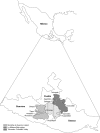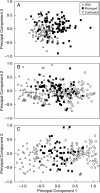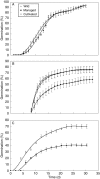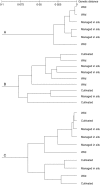In situ management and domestication of plants in Mesoamerica - PubMed (original) (raw)
Review
. 2007 Nov;100(5):1101-15.
doi: 10.1093/aob/mcm126. Epub 2007 Jul 25.
Affiliations
- PMID: 17652338
- PMCID: PMC2759202
- DOI: 10.1093/aob/mcm126
Review
In situ management and domestication of plants in Mesoamerica
Alejandro Casas et al. Ann Bot. 2007 Nov.
Abstract
Background and aims: Ethnobotanical studies in Mexico have documented that Mesoamerican peoples practise systems of in situ management of wild and weedy vegetation directed to control availability of useful plants. In situ management includes let standing, encouraging growing and protection of individual plants of useful species during clearance of vegetation, which in some cases may involve artificial selection. The aim of this study was to review, complement and re-analyse information from three case studies which examined patterns of morphological, physiological and genetic effects of artificial selection in plant populations under in situ management in the region.
Methods: Information on wild and in situ managed populations of the herbaceous weedy plants Anoda cristata and Crotalaria pumila, the tree Leucaena esculenta subsp. esculenta and the columnar cacti Escontria chiotilla, Polaskia chichipe and Stenocereus stellatus from Central Mexico was re-analysed. Analyses compared morphology and frequency of morphological variants, germination patterns, and population genetics parameters between wild and managed in situ populations of the species studied. Species of columnar cacti are under different management intensities and their populations, including cultivated stands of P. chichipe and S. stellatus, were also compared between species.
Key results: Significant differences in morphology, germination patterns and genetic variation documented between wild, in situ managed and cultivated populations of the species studied are associated with higher frequencies of phenotypes favoured by humans in managed populations. Genetic diversity in managed populations of E. chiotilla and P. chichipe is slightly lower than in wild populations but in managed populations of S. stellatus variation was higher than in the wild. However, genetic distance between populations was generally small and influenced more by geographic distance than by management.
Conclusions: Artificial selection operating on in situ managed populations of the species analysed is causing incipient domestication. This process could be acting on any of the 600-700 plant species documented to be under in situ management in Mesoamerica. In situ domestication of plants could be relevant to understand early processes of domestication and current conditions of in situ conservation of plant genetic resources.
Figures
Fig. 1.
Map of the study area giving the location of Montaña de Guerrero, La Mixteca Baja and the Tehuacán-Cuicatlán Valley in central Mexico.
Fig. 2.
Least square means (LSM) obtained from generalized linear model (GENMOD procedure SAS, 200) for total number of individual plants per hectare (in logarithmic scale) of the variants ‘hembra’ (white columns) and ‘macho’ (shaded columns) of Anoda cristata and Crotalaria pumila in different habitats (TD, tropical dry forest; FAF, fallow agricultural fields; SAF, seasonal agricultural fields; IAF, irrigated agricultural fields) in La Montaña de Guerrero, Central Mexico. The error bar represents standard errors; some of them are not evident because they were small. For Anoda cristata, in the analysis for habitat _F_3,32 = 22·81, P < 0·0001, for variant type _F_1,32 = 198·43, P < 0·0001, and for the interaction between habitat and variant type _F_3,32 = 724·23, P < 0·0001. For Crotalaria pumila in the analysis for habitat _F_3,32 = 33·51, P < 0·0001, for variant type _F_1,32 = 12·04, P < 0·0015, and for the interaction between habitat and variant type _F_3,32 = 60·54, P < 0·0001.
Fig. 3.
Classification of individuals of Leucaena esculenta subsp. esculenta from wild and managed in situ populations from Alcozauca and Amapilca, Guerrero, Central Mexico. The classification pattern resulted from PCA of morphological variation within the space of the first and second principal components.
Fig. 4.
Classification of individuals from wild, managed in situ, and cultivated populations of (A) Escontria chiotilla (based on Arellano and Casas, 2003), (B) Polaskia chichipe (based on Carmona and Casas, 2005) and (C) Stenocereus stellatus (based on Casas et al., 1999_b_) of Central Mexico. The classification resulted from PCA of morphological variation within the space of the first two principal components.
Fig. 5.
Germination percentage of seeds from wild, managed in situ, and cultivated populations of (A) Escontria chiotilla, (B) Polaskia chichipe (based on Otero-Arnaiz et al., 2003), and (C) Stenocereus stellatus (based on Rojas-Aréchiga et al., 2001) from the Tehuacán-Cuicatlán Valley and La Mixteca Baja region, Central Mexico.
Fig. 6.
Genetic distance (Nei, 1973) of wild, managed in situ and cultivated populations of (A) Escontria chiotilla (based on Tinoco et al., 2005), (B) Polaskia chichipe (Otero-Arnaiz et al. 2005_a_; Lucio, 2005) and (C) Stenocereus stellatus (based on J. Cruse et al., University of Georgia, USA, unpubl. res.) from Central Mexico.
Similar articles
- Use and management of wild fauna by people of the Tehuacán-Cuicatlán Valley and surrounding areas, Mexico.
Zarazúa-Carbajal M, Chávez-Gutiérrez M, Romero-Bautista Y, Rangel-Landa S, Moreno-Calles AI, Ramos LFA, Smith SE, Blancas J, Del Val E, Del Coro Arizmendi M, Casas A. Zarazúa-Carbajal M, et al. J Ethnobiol Ethnomed. 2020 Jan 28;16(1):4. doi: 10.1186/s13002-020-0354-8. J Ethnobiol Ethnomed. 2020. PMID: 31992326 Free PMC article. Review. - Differential survival and growth of wild and cultivated seedlings of columnar cacti: Consequences of domestication.
Guillén S, Casas A, Terrazas T, Vega E, Martínez-Palacios A. Guillén S, et al. Am J Bot. 2013 Dec;100(12):2364-79. doi: 10.3732/ajb.1300241. Epub 2013 Dec 3. Am J Bot. 2013. PMID: 24302692 - Genetic variation and evolution of Polaskia chichipe (Cactaceae) under domestication in the Tehuacán Valley, central Mexico.
Otero-Arnaiz A, Casas A, Hamrick JL, Cruse-Sanders J. Otero-Arnaiz A, et al. Mol Ecol. 2005 May;14(6):1603-11. doi: 10.1111/j.1365-294X.2005.02494.x. Mol Ecol. 2005. PMID: 15836636 - Landscape management and domestication of Stenocereus pruinosus (Cactaceae) in the Tehuacán Valley: human guided selection and gene flow.
Parra F, Blancas JJ, Casas A. Parra F, et al. J Ethnobiol Ethnomed. 2012 Aug 14;8:32. doi: 10.1186/1746-4269-8-32. J Ethnobiol Ethnomed. 2012. PMID: 22891978 Free PMC article. - Brazilian and Mexican experiences in the study of incipient domestication.
Lins Neto EM, Peroni N, Casas A, Parra F, Aguirre X, Guillén S, Albuquerque UP. Lins Neto EM, et al. J Ethnobiol Ethnomed. 2014 Apr 2;10:33. doi: 10.1186/1746-4269-10-33. J Ethnobiol Ethnomed. 2014. PMID: 24694009 Free PMC article. Review.
Cited by
- Adaptation and biocultural conservation of traditional agroforestry systems in the Tehuacán Valley: access to resources and livelihoods strategies.
Vázquez-Delfin P, Casas A, Vallejo M. Vázquez-Delfin P, et al. Heliyon. 2022 Jun 27;8(7):e09805. doi: 10.1016/j.heliyon.2022.e09805. eCollection 2022 Jul. Heliyon. 2022. PMID: 35800250 Free PMC article. - Human diets drive range expansion of megafauna-dispersed fruit species.
van Zonneveld M, Larranaga N, Blonder B, Coradin L, Hormaza JI, Hunter D. van Zonneveld M, et al. Proc Natl Acad Sci U S A. 2018 Mar 27;115(13):3326-3331. doi: 10.1073/pnas.1718045115. Epub 2018 Mar 12. Proc Natl Acad Sci U S A. 2018. PMID: 29531027 Free PMC article. - Use of columnar cacti in the Tehuacán Valley, Mexico: perspectives for sustainable management of non-timber forest products.
Pérez-Negrón E, Dávila P, Casas A. Pérez-Negrón E, et al. J Ethnobiol Ethnomed. 2014 Dec 23;10:79. doi: 10.1186/1746-4269-10-79. J Ethnobiol Ethnomed. 2014. PMID: 25539885 Free PMC article. - Herding Ecologies and Ongoing Plant Domestication Processes in the Americas.
Lezama-Núñez PR, Santos-Fita D, Vallejo JR. Lezama-Núñez PR, et al. Front Plant Sci. 2018 May 17;9:649. doi: 10.3389/fpls.2018.00649. eCollection 2018. Front Plant Sci. 2018. PMID: 29868099 Free PMC article. Review. - Use and management of wild fauna by people of the Tehuacán-Cuicatlán Valley and surrounding areas, Mexico.
Zarazúa-Carbajal M, Chávez-Gutiérrez M, Romero-Bautista Y, Rangel-Landa S, Moreno-Calles AI, Ramos LFA, Smith SE, Blancas J, Del Val E, Del Coro Arizmendi M, Casas A. Zarazúa-Carbajal M, et al. J Ethnobiol Ethnomed. 2020 Jan 28;16(1):4. doi: 10.1186/s13002-020-0354-8. J Ethnobiol Ethnomed. 2020. PMID: 31992326 Free PMC article. Review.
References
- Alcorn JB. Huastec noncrop resource management: implications for prehispanic rain forest management. Human Ecology. 1981;9:395–417.
- Alcorn JB. El te'lom huasteco: presente, pasado y futuro de un sistema de silvicultura indígena. Biótica. 1983;8:315–331.
- Alcorn JB. Huastec Mayan ethnobotany. Austin, TX: University of Texas Press; 1984.
- Arellano E, Casas A. Morphological variation and domestication of Escontria chiotilla (Cactaceae) under silvicultural management in the Tehuacán Valley, Central Mexico. Genetic Resources and Crop Evolution. 2003;50:439–453.
- Barrera A, Gómez-Pompa A, Vázquez-Yañes C. El manejo de las selvas por los Mayas sus implicaciones silvícolas y agrícolas. Biótica. 1977;2:47–61.





